A small cave salamander, nicknamed "the human fish" because of its human-like skin tone, has just broken the world's record for longest-lived amphibian, according to a new study.
The salamander, also called olm and Proteus, has a maximum lifespan of over 100 years, concludes the new study, published in the latest Royal Society Biology Letters. That's nearly double the age of other often-elderly amphibians: the Japanese giant salamander (55 years), the African bullfrog (45 years), the common European toad (40 years) and the mudpuppy (34 years).
"Among amphibians the human fish is clearly the most long-lived species," lead author Yann Voituron told Discovery News.
Voituron, a professor at Claude Bernard Lyon University, and his team calculated growth rates, generation times and the lifespan of olms living in a cave at Moulis, Saint-Girons, France. Since the 1950s, conservationists have established a breeding program there for the threatened salamanders.
In addition to determining the lifespan of the cave salamanders, the researchers found that this species becomes sexually mature at around age 16 and lays, on average, 35 eggs every 12.5 years.
"What promotes its longevity is probably very low activity, low reproduction, no environmental stress and its peculiar physiology," Voituron said.
He described "the human fish" as having a snakelike body, up to 16 inches long. It is blind, with eyes regressed and covered by a layer of skin. The human-like skin tone derives from oxygen-rich blood that shows through the salamander's non-pigmented skin.
It also looks unisex.
"The sexes are very similar in appearance, with males having a somewhat thicker cloaca (posterior opening) than females," he said.
Scientists have been interested in the lifespan of this salamander for some time, since zookeepers started to notice that olms in exhibits would live to amazingly advanced ages, usually over 70 years.
Analysis of this, and other elderly animals, might shed light on what promotes longevity in general. The olm seems to fit a pattern, where long lives are dependent upon low-stress, stable environments without predators. Beyond that, however, the latest findings have researchers puzzled.
That's because longevity used to be tied to relatively large animals. The previous age record-holder for amphibians, for example, was the Japanese giant salamander, which is the world's second largest salamander, growing to nearly 5 feet and weighing over 55 pounds.
Possessing a reduced metabolic rate also seems to lead to a longer life. But as Voituron and his team mention, "compared with other amphibians, the olm's basal metabolic rate is not markedly different." The salamander also does not possess noteworthy antioxidant activity, another predictor of longevity.
"In other words, the olm presents a paradox, since neither its basal metabolic rate nor its antioxidant activity, the two most cited mechanisms which should be involved in enhancing lifespan, differ from species with a more reduced lifespan," according to the scientists.
Lilijana Bizjak Mali, a University of Ljubjana biologist, has also extensively studied the salamander.
Mali told Discovery News she agrees with the new findings, which she believes are "very interesting" and "scientifically correct," save for the mention that olms have a metabolic rate comparable to that of other amphibians. Prior research, she said, proves that the salamander "has a considerably lower metabolic rate than those of most surface-dwelling amphibians."
All of the scientists plan to further study the cave salamander to hopefully shed light on the animal kingdom's "fountain of youth" secrets, which might one day lead to methods of increasing our own lifespan.
